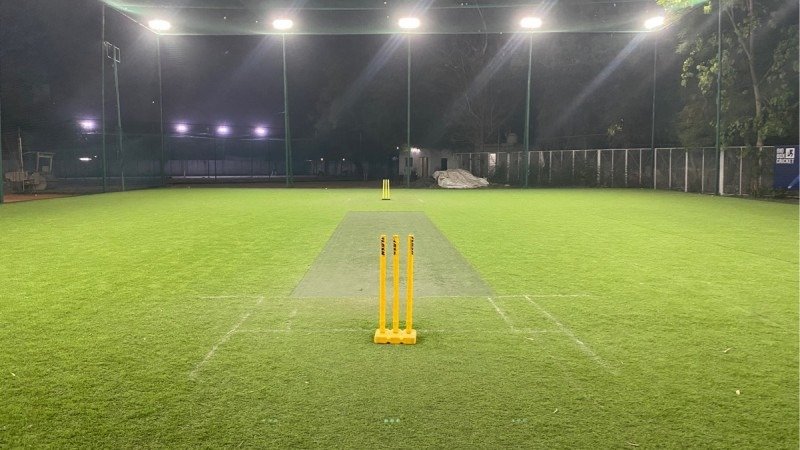A Complete Guide to Box Cricket Rules and Regulations

Cricket enthusiasts all across the world are enthralled with Box Cricket, also known as turf cricket, particularly in places where space is at a premium. This game has grown in popularity, appealing to both adults seeking a quick cricket thrill and school-age children. Read below to know everything about Box Cricket rules and regulations.

Box Cricket: What Is It?
Box Cricket, also known as turf box cricket, is a shorter version of cricket that is usually played in a box, as the name suggests, which is a smaller, defined area. The gameplay and scoring are very similar to traditional cricket, but special rules are included to accommodate the smaller playing field. The following are some of the main traits of Box Cricket:
- The field of play is a much smaller “box,” either rectangular or square, than a conventional cricket pitch.
- Less players are needed for the game to function, which increases engagement.
- Box Cricket rules were changed to allow for smaller spaces for play.
Why Is Box Cricket So Popular?
Box Cricket is an attractive choice for urban dwellers because it allows those who love cricket to play their favorite game in limited spaces. It is very engaging due to its simplicity and short duration, encouraging physical activity without requiring a large time commitment. It’s also very exciting and enjoyable, which makes it a great option for friendly peer competitions and informal afternoon games. Box Cricket rules are highly popular in cricket-loving nations like India. In essence, it’s cricket available whenever, wherever!

The Box Cricket History
Let’s take a look at Box Cricket’s history as we start our journey.
The origins of Box Cricket, a small-format version of traditional cricket, can be found in India’s urban regions, particularly in crowded cities where traditional cricket grounds are a luxury. With the advent of this tiny version of cricket, players could now enjoy their favorite game without the need for a large field by playing it inside a box or other small, usually enclosed space.
Turf cricket, also known as Box Cricket, has changed over time as a result of shifting environmental factors. To improve gameplay, several modifications have been made to the turf cricket rules and equipment. Among these changes are:
- A reduction in team size—typically six players per side
- Soft tennis balls have been introduced to reduce injuries.
- Netted playing area that is enclosed to keep the ball in a specific area
- Set batting times for a predetermined amount of time
Due to these modifications, Box Cricket has gained popularity as a compelling substitute for traditional cricket.
Box Cricket Rules
Let’s start by discussing the game’s regulations. Like traditional cricket, box cricket rules are designed to keep the spirit of fair play intact while making the game fun and simple to comprehend.
Players and Teams
Eight players make up a team in box or turf cricket. Since this is indoor cricket, all players (aside from the bowler and wicketkeeper) are free to field wherever they choose.
Innings and Toss
Teams flip a coin to start a match. It is up to the winning team to decide whether to bowl or bat first. Eight overs make up each innings, for a total of 16 overs in a game. In contrast to normal cricket, each side is given just one innings.

Runs Scoring
The rules for scoring runs in Box Cricket are quite simple:
- A run scored during the ball’s in-play is worth one point.
- A ball that strikes the side nets without making contact with the ground is worth two runs.
- Four runs are scored if the ball makes it directly to the net.
- If the ball strikes the roof net, six runs are scored.
Dismissals and Outs
Similar to traditional cricket, box or turf cricket dismissals include bowled, stumped, caught, and run-out. Nevertheless, the idea calls for “two outs” as opposed to “one out.” Even after being out, the batsman can continue to bat; the only consequence is a three-run deduction each time.
There are several ways to dismiss a batsman in Box Cricket. Now let’s examine them:
1. Bowled: The batsman is out if the ball strikes the stumps directly and removes at least one bail. If the ball strikes the bat or any other part of the body before it reaches the stumps, it makes no difference.
2. Caught: The batsman is out if a fielder catches the ball that he or she hits without it bouncing off the ground. The fielder needs to catch the ball inside the lines while maintaining complete control over it.
3. Run Out: The batsman is out of the game if the fielding team uses the ball to successfully break the wicket while the batsman is out of the crease or hasn’t made a whole run. At least one bail must be taken out of the stumps by the fielding team in order to maintain possession of the ball.
4. Stumped: The wicketkeeper can remove the bails before the batsman returns if he leaves the crease to play a shot and misses the ball. If it works, the batter is out.
5. Leg Before Wicket (LBW): The batsman may be declared out LBW if the ball strikes his or her legs and the umpire determines that the ball would have struck the stumps instead. In Box Cricket, though, this method of dismissal is typically not taken into account.
6. Hit Wicket: The batsman is out if, in the process of trying a shot or sprinting between the wickets, they unintentionally knock off the bails.
These are the standard methods to be dismissed in Box Cricket, but remember that the rules can change based on the particular game being played.
Fielding Restrictions and Boundaries
Fielding restrictions do not typically apply to Box Cricket rules. To prevent collisions, it is strictly advised not to field too near to the batting crease.
Penalties and Extras
The teams’ totals are increased by extras like “wides” and “no-balls” in addition to regular runs. Nonetheless, there are some pretty severe penalties under the Box Cricket rules. For every over that isn’t bowled in the allocated time, there is a five-run fine. In addition, actions that go against the spirit of fair play are met with consequences, guaranteeing that everyone can continue to enjoy the game.
Regulations for Box Cricket
It’s crucial that you become familiar with a few essential Box Cricket rules before you begin playing. Let’s examine them now!
Pitch Dimensions and Venue
Box cricket is typically played indoors or in smaller outdoor areas because the playing area is typically smaller than that of traditional cricket. The pitch is typically between 18 and 22 yards long and 6 and 10 yards wide, to put things into perspective. Nonetheless, the wicket keeps its customary measurements of 9 inches in width and 28 inches in height. The play area’s perimeter is often marked with stakes or poles.
Regulations for Equipment
The equipment guidelines come with the Box Cricket rules in addition to the gameplay guidelines. It comes with a standard cricket bat, stumps, and bails, as well as a tennis ball in place of the customary cricket ball. With the softer and lighter ball being used, gloves, pads, and helmets are typically not necessary.
Roles of Umpire and Referee
An umpire’s role in Box Cricket is crucial. They supervise the game in addition to ensuring that all rules are followed while playing. In contrast, the referee is in charge of mediating disagreements and rendering judgment calls that have an impact on the game as a whole.
Box Cricket Code of Conduct
Players of Box Cricket are expected to maintain a certain code of conduct. Acts of inappropriate behavior, insulting remarks, or aggression are strongly prohibited and may result in instant disqualification from the match. Certain agreements require prior discussion, such as the rules for bowling underarm cricket.
Spirit of the Game and Fair Play
The idea of fair play lies at the foundation of Box Cricket regulations. It promotes respect, cooperation, and sportsmanship among participants. As such, deliberate unsportsmanlike behavior or cheating is not permitted and may result in consequences. Never forget that having fun with the game should take precedence over winning or losing.
Box Cricket Tips For Playing
Despite having a much smaller playing field than typical, Box Cricket still provides players with an exhilarating challenge and a high level of adrenaline. You’ve come to the correct spot if you want to improve your Box Cricket abilities. We’ve put together some excellent advice to help you improve your game.
Tip for Batting
Batting in box or turf cricket requires controlled power because of the restricted space. Here are a few brief pointers:
- To hit the ball precisely within the ground, practice taking controlled swings.
- Maintain a firm grip while being flexible and balanced.
- To control the trajectory of the ball, use your wrist power
Tips for Bowling
Due to the smaller playing field, bowling in box or turf cricket is a difficult endeavor. Here are some methods to help you become a better bowler:
- To trick the batter, change up the length and pace of your deliveries.
- For best results, practice swing and spin bowling on a regular basis.
Tips for Fielding
Because of the small playing field, Box Cricket has an interesting feature where fielding is an active role. The following advice will help you field effectively:
- With short workouts, you can increase your agility and ensure faster movements.
- Develop your catching abilities because well-made catches can alter the outcome of a game.
Keep in mind that preparation pays off, and following these pointers will undoubtedly help you succeed in the Box Cricket arena!

In conclusion
A great way to enjoy your favorite sport without requiring a big playground or expensive equipment is to play Box Cricket. Try your hand at box cricket; there’s probably a club or league near you. It’s an excellent way to maintain your fitness, meet new people, and have fun in a competitive setting.
In conclusion, Box Cricket provides everyone with all the thrill, strategy, and difficulty of traditional cricket in an affordable package. All ages and skill levels of cricket enthusiasts can enjoy this game. Now that you have this overview of the guidelines, you can enter the box and begin playing. I hope each and every game you play is exciting!
Also Read: Shares Pledging: Meaning, Advantages, and Stock Margin Effects?
Shares Pledging: Meaning, Advantages, and Stock Margin Effects?
Also Read: How To Write Application In Sanskrit – संस्कृत में आवेदन पत्र लेखन
How To Write Application In Sanskrit – संस्कृत में आवेदन पत्र लेखन
Also Read: How To Identify Bhringraj Plant? Know All It’s Benefits and Uses
How To Identify Bhringraj Plant? Know All It’s Benefits and Uses
Leave a Comment